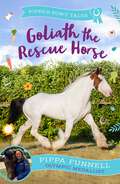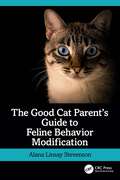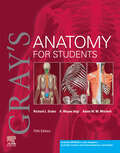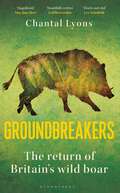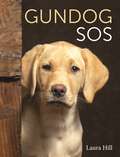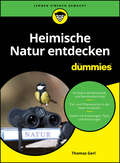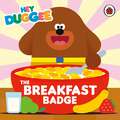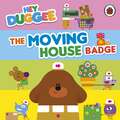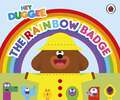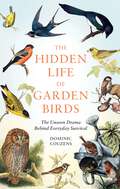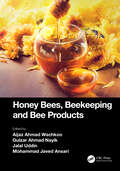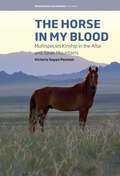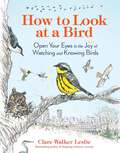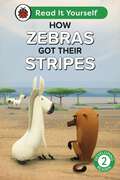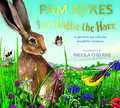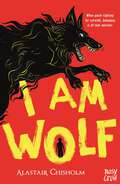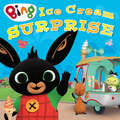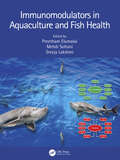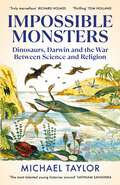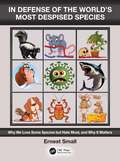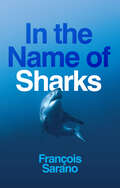- Table View
- List View
Goliath the Rescue Horse (Pippa's Pony Tales #13)
by Pippa FunnellTilly dreams of having a pony of her own. One that only she can ride to stardom. Will her wishes come true when she joins Silver Shoe Farm Stables?Tilly learns all about World Horse Welfare and, when she visits their rehabilitation centre, she falls in love with gentle giant, Goliath, the shire horse. What can she do to help find him a new home?Collect all 18 titles in this series of irresistible, uplifting and heartwarming pony adventures. Printed in a dyslexia friendly font and packed with up to date tips from three times Olympic Medallist, Pippa Funnell, as well as a helpful glossary and black and white illustrations on every spread.
The Good Cat Parent’s Guide to Feline Behavior Modification
by Alana Linsay StevensonCats are cuddly and adorable, but they are often misunderstood. Sadly, many cats are relinquished to shelters or rehomed due to normal behaviors that are incorrectly treated or mishandled. In this book, Elite Fear-Free and Low-Stress Handling Certified author Alana Linsay Stevenson empowers cat parents and teaches them how to address and modify challenging feline behavior.You will begin by learning basic kitten care and feline developmental stages; how cats differ behaviorally from group animals, such as dogs and people; feline body language; and how cats handle stress. Alana provides concise instruction on how to gently handle cats: how to pick up and carry them, acclimate them to carriers, the use of towels, alternatives to scruffing, and how our body language affects cats. Packed with photographs for visual reference, this book offers clear guidelines and easily implementable strategies for resolving feline behavioral problems, such as: failure to use the litter box play aggression petting aggression inter-cat aggression furniture scratching jumping on counters obsessing about food night wailing fear of people aggression to strangers The content is organized by topic for easy access to information, as you need it.The Good Cat Parent’s Guide to Feline Behavior Modification is for anyone who likes cats and wants to learn more about them. Whether you are a veterinary professional, a volunteer or shelter worker who regularly handles stressed cats, or a cat parent who simply wants to understand your cat, you will find helpful and useful information at your fingertips to give cats a better quality of life. No cat parent should be without this book!
The Good Cat Parent’s Guide to Feline Behavior Modification
by Alana Linsay StevensonCats are cuddly and adorable, but they are often misunderstood. Sadly, many cats are relinquished to shelters or rehomed due to normal behaviors that are incorrectly treated or mishandled. In this book, Elite Fear-Free and Low-Stress Handling Certified author Alana Linsay Stevenson empowers cat parents and teaches them how to address and modify challenging feline behavior.You will begin by learning basic kitten care and feline developmental stages; how cats differ behaviorally from group animals, such as dogs and people; feline body language; and how cats handle stress. Alana provides concise instruction on how to gently handle cats: how to pick up and carry them, acclimate them to carriers, the use of towels, alternatives to scruffing, and how our body language affects cats. Packed with photographs for visual reference, this book offers clear guidelines and easily implementable strategies for resolving feline behavioral problems, such as: failure to use the litter box play aggression petting aggression inter-cat aggression furniture scratching jumping on counters obsessing about food night wailing fear of people aggression to strangers The content is organized by topic for easy access to information, as you need it.The Good Cat Parent’s Guide to Feline Behavior Modification is for anyone who likes cats and wants to learn more about them. Whether you are a veterinary professional, a volunteer or shelter worker who regularly handles stressed cats, or a cat parent who simply wants to understand your cat, you will find helpful and useful information at your fingertips to give cats a better quality of life. No cat parent should be without this book!
Gray's Anatomy for Students E-Book: Gray's Anatomy for Students E-Book (Gray's Anatomy)
by Richard L. Drake A. Wayne Vogl Adam W.M. MitchellConcise, readable text and an outstanding art program make Gray's Anatomy for Students, 5th Edition, your go-to text for essential information in human anatomy. This fully revised volume focuses on the core information medical students need to know, in an easy-access format and with additional multimedia content to facilitate effective study and mastery of the material. A team of expert authors share a wealth of diverse teaching and clinical experience—all enhanced by more than 1,000 innovative, original illustrations by renowned illustrators Richard Tibbitts and Paul Richardson, who capture anatomical features with unrivalled clarity. Helps you understand the practical applications of anatomical concepts through unique coverage of surface anatomy, correlative diagnostic images, and clinical case studies. Contains increased representation of diverse population groups throughout, incorporating a wider range of skin tones and important clinical considerations related to transgender and intersex individuals. Presents anatomy logically by body region – as well as bonus updated eBook chapters for each major body system to facilitate learning from a different perspective. Includes new and improved online materials such as self-assessment questions, medical and physical therapy clinical cases, a unique Interactive Surface Anatomy tool, and more. Provides fully revised and updated clinical content including numerous new In the Clinic boxes, images, and correlates throughout that reflect the latest advances seen in clinical practice. New and updated Clinical Cases are included in the accompanying enhanced eBook. Features an updated neuroanatomy eBook chapter, so you can learn key aspects of this challenging topic in the context of general anatomy. Improves comprehension of complex cranial nerves with a visual map summarizing cranial nerve distribution and function. Offers schematic drawings for key structures and topics in every chapter, providing an additional, simplified approach to introduce each topic—ideal for quick initial understanding and as a guide for your own anatomy drawings. Enables you to quickly review the basic concepts from each chapter with Conceptual Overviews. Evolve Instructor site with a downloadable image bank is available to instructors through their Elsevier sales rep or via request at https://evolve.elsevier.com.
Groundbreakers: The Return of Britain’s Wild Boar
by Chantal Lyons'Full of joy, pathos, warmth, integrity and intrigue.' AMY-JANE BEER'A thrilling expedition into a wild, unruly world.' LEE SCHOFIELD 'Gently thought-provoking and beautifully written.' LEIF BERSWEDEN'A real page-turner.' STEPHEN MOSSAfter centuries of absence, wild boar are back in Britain. What does this mean for us – and them?Big, messy and mysterious – crossing paths with a wild boar can conjure fear and joy in equal measure. Driven to extinction seven hundred years ago, a combination of the species' own tenacity and illegal releases from the 1980s has seen several populations of this beast of myth begin to roam English and Scottish woods once more.With growing worry over the impacts on both people and the countryside, the boar's right to exist in Britain has been heavily debated. Their habitat-regenerating actions benefit a host of other wildlife, yet unlike beavers, these ecosystem engineers remain unloved by many. Why is there no clamour to reintroduce them across the land? And, with the few boar in England threatened by poaching and culling, why are we not doing more to prevent their re-extinction? In Groundbreakers, Chantal Lyons moves to the boar's stronghold of the Forest of Dean to get up close and personal with this complex, intelligent and quirky species, and she meets with people across Britain and beyond who celebrate their presence – or want them gone. From Toulouse and Barcelona where they are growing in number and boldness, to the woods of Kent and Sussex where they are fading away again, to Inverness-shire where rewilders welcome them, join Chantal on a journey of discovery as she reveals what it might take for us to coexist with wild boar.
Gundog SOS
by Laura HillIn Gundog SOS, respected trainer, judge and competitor Laura Hill takes an in-depth look at common mistakes and what can be learnt from them. She looks at avoiding potential pitfalls in the first place, unpacks 'bad behaviour', analyses the relevance of the relationship between trainer and dog, and gives practical strategies for improvement in training partnerships. Supported by illustrations, case studies and exercises, this essential resource comprehensively addresses the most frequently occurring training problems and provides workable solutions to help readers to improve or fix them.
Heimische Natur entdecken für Dummies (Für Dummies)
by Thomas GerlEntdecken Sie Wunder der Natur direkt vor der eigenen Haustür Entdecken Sie, was die Natur zu bieten hat. Dazu müssen Sie nicht weit reisen, sondern beginnen direkt vor Ihrer Haustür. Thomas Gerl erklärt Ihnen, was es über die größten heimischen Naturräume zu wissen gibt. Sie lernen die jeweiligen Besonderheiten und die interessantesten Bewohner kennen. So bekommen Sie ein eindrückliches Bild von den Lebewesen Ihrer Region, angereichert mit biologischen Hintergrundinformationen und vielen praktischen Tipps für erfolgreiche Naturbeobachtungen. An konkreten Beispielen erfahren Sie außerdem, wie sich der Rückgang der biologischen Vielfalt auswirkt und wie Sie dabei helfen, ihn zu stoppen. Sie erfahren Wie sich die Vielfalt des Lebendigen ordnen lässt Was Sie bei Erkundungstouren in der Natur beachten sollten Wo und wie Sie bestimmte Tiere und Pflanzen finden Wie Naturbeobachtung dazu beiträgt, Lebewesen zu erhalten
Hey Duggee: The Breakfast Badge
by Hey DuggeeTag is very hungry at the clubhouse today . . . he's forgotten to eat his breakfast!Join Duggee and the Squirrels as they discover the different types of food for breakfast.What will they end up choosing to eat?MUNCH, CRUNCH, CHOMP!Want more Duggee? Try:Hey Duggee: Duggee's TractorHey Duggee: The Pet BadgeHey Duggee: The Train Badge
Hey Duggee: The Moving House Badge (Hey Duggee)
by Hey DuggeeMoving house can be hard. Can Duggee and the Squirrels help Snail to move house easily?Join everyone's favourite dog in this funny tale for budding young Squirrels!Duggee teaches the Squirrels to LIFT, PUSH, PULL and ROLL to move Snail's things efficiently.Want more Duggee? Try:Hey Duggee: The Potty BadgeHey Duggee: The Handwashing BadgeHey Duggee: The Football Badge
Hey Duggee: The Rainbow Badge (Hey Duggee)
by Hey DuggeeDuggee and the Squirrels are outside enjoying the rain when suddenly . . . it stops raining, the sun comes out and a beautiful rainbow appears!Join the Squirrels as they learn all about colours and even make their own rainbow. Can you help them find all the right colours?One more thing. . . DUGGEE HUG! Want more Duggee? Also available:Hey Duggee: The Breakfast BadgeHey Duggee: The Shape BadgeHey Duggee: Getting Ready for Bed Badge
The Hidden Life of Garden Birds: The unseen drama behind everyday survival
by Dominic CouzensA glimpse into the secret lives of over 50 garden birds, with beautiful illustrations and intriguing factsDid you know that woodpeckers are capable of learning simple codes? Hooded crows can form connections with humans? A jay's call affects the behaviour of surrounding squirrels?All these fascinating bird activities and more are revealed in The Hidden Life of Garden Birds. Unusual feeding behaviour is just the tip of the iceberg. From territorial conflict and strange relationships with man, to breeding and nesting oddities, this book exposes all the drama behind garden birds' everyday survival - making it the perfect gift for birdwatchers.The Hidden Life of Garden Birds will enlighten you to the secret going-ons of the common creatures you can spot from the comfort of your back doorstep.
Honey Bees, Beekeeping and Bee Products
by Aijaz Ahmad Wachkoo, Gulzar Ahmad Nayik, Jalal Uddin and Mohammad Javed AnsariHoney bees are social insects; they live together in large, well-organized family groups comprising three castes: queen (fertile female), workers (sterile females) and drones (males). During honey flow season, there is a considerable increase in the foraging activity of the workers and in the rate of egg laying by the queen. Sex determination in honey bees involves a multi-allelic locus, such that homozygotes develop as males and heterozygotes as females, whereas diet quality influences the caste determination in honey bees. Like all living organisms, honey bees can be infested with diseases and pests. Some of these are more deleterious to bee colonies than others, but it is important for the beekeeper to be able to recognize conditions that might be disease or pest-related and respond accordingly so as to improve the quality of honey and honey bee by-products.The best-known primary products of beekeeping are honey and wax, but pollen, propolis, royal jelly, venom, queens, bees and their larvae are also marketable primary bee products. The purpose of this book is to make available information on bee biology and beekeeping as well as to provide comprehensive information on manufacturing, processing and marketing of value-added bee products.This book has been designed as a useful tool for the many diverse professionals who characterize and market honey bee products, including beekeepers, non-beekeepers, small entrepreneurs, extension officers and those involved in small business development. This edited book will be the first of its kind to contain comprehensive information on both bees and bee products.Key Features: Contains comprehensive information on beekeeping. Discusses the recent advances in beekeeping. Sheds light on bee colony integration and organization. Contains brief information on honey bee products.
Honey Bees, Beekeeping and Bee Products
Honey bees are social insects; they live together in large, well-organized family groups comprising three castes: queen (fertile female), workers (sterile females) and drones (males). During honey flow season, there is a considerable increase in the foraging activity of the workers and in the rate of egg laying by the queen. Sex determination in honey bees involves a multi-allelic locus, such that homozygotes develop as males and heterozygotes as females, whereas diet quality influences the caste determination in honey bees. Like all living organisms, honey bees can be infested with diseases and pests. Some of these are more deleterious to bee colonies than others, but it is important for the beekeeper to be able to recognize conditions that might be disease or pest-related and respond accordingly so as to improve the quality of honey and honey bee by-products.The best-known primary products of beekeeping are honey and wax, but pollen, propolis, royal jelly, venom, queens, bees and their larvae are also marketable primary bee products. The purpose of this book is to make available information on bee biology and beekeeping as well as to provide comprehensive information on manufacturing, processing and marketing of value-added bee products.This book has been designed as a useful tool for the many diverse professionals who characterize and market honey bee products, including beekeepers, non-beekeepers, small entrepreneurs, extension officers and those involved in small business development. This edited book will be the first of its kind to contain comprehensive information on both bees and bee products.Key Features: Contains comprehensive information on beekeeping. Discusses the recent advances in beekeeping. Sheds light on bee colony integration and organization. Contains brief information on honey bee products.
The Horse in My Blood: Multispecies Kinship in the Altai and Saian Mountains (Interspecies Encounters #4)
by Victoria Soyan PeemotA fascinating interspecies relationship can be seen among the horse breeding pastoralists in the Altai and Saian Mountains of Inner Asia. Victoria Soyan Peemot herself grew up in a community with close human-horse relationships and uses her knowledge of the local language and horsemanship practices. Building upon Indigenous research epistemologies, she engages with the study of how the human-horse relationships interact with each other, experience injustices and develop resilience strategies as multispecies unions.
How to Look at a Bird: Open Your Eyes to the Joy of Watching and Knowing Birds
by Clare Walker LeslieBestselling author and acclaimed nature illustrator Clare Walker Leslie invites beginning birdwatchers to hone their observational skills with this easy-to-use visual guide. Using her signature nature journal illustrations, Leslie shows readers the key clues to look for, from the shape of the beak or talons to distinctive feather colorings, flight patterns, and behavioral traits. She offers simple prompts that encourage readers to embrace curiosity and take a closer look: Where are you? What season is it? How is that bird moving or eating? With an emphasis on the birds that are most likely to be seen at a feeder, in a city park, or at a nature preserve, How to Look at a Bird makes bird watching, identification, and appreciation accessible to everyone, no matter where they live. This publication conforms to the EPUB Accessibility specification at WCAG 2.0 Level AA.
How Zebras Got Their Stripes: Read It Yourself - Level 2 Developing Reader (Read It Yourself)
by LadybirdBased on the classic West African folktale about bravery. Why are zebras stripy, and why do baboons have red bottoms? Find out what happens when a bossy baboon and a plucky little zebra go head-to-head, with long-lasting consequences.How Zebras Got Their Stripes is from Developing Reader Level 2 and is ideal for readers aged from 5+ who can read short, simple sentences with help.Each book has been carefully checked by educational and subject consultants and includes comprehension puzzles, book band information, and tips for helping children with their reading.With five levels to take children from first phonics to fluent reading and a wide range of different stories and topics for every interest, Read It Yourself helps children build their confidence and begin reading for pleasure.
I am Hattie the Hare: A tale from our wild and wonderful meadows
by Pam AyresJoin Hattie the playful Brown Hare as she leaps from meadow to farm to heath, in this heartwarming tale written in rhyme by the much-loved poet Pam Ayres, author of The Last Hedgehog.We didn’t always live here, once we had a sunny home,We came here with centurions, all the way from Rome . . .From grape green meadows to old-fashioned farms, hares travelled thousands of miles to find a home in the British countryside. What do they eat? What's their perfect habitat? Can you tell them apart from rabbits?Wonderfully illustrated by award-winning artist Nicola O'Byrne, I Am Hattie the Hare is a follow-up to the bestselling I Am Oliver the Otter. Bursting with natural and historical facts interwoven throughout the story, and with an information spread at the end that includes tips on where to spot these gentle animals.
I Am Wolf (I Am Wolf)
by Alastair ChisholmAn outstanding, highly original and unputdownable read! This is a bold, thought-provoking adventure perfect for fans of MORTAL ENGINES and THE LAST WILD. "I loved every page of this gripping, dystopian thriller. Wonderful characters, thrilling action and a unique new world. Now I wish I had my own animal construct!" Kieran Larwood, author of Podkin One Ear "I wolfed this down... Great MG sci-fi." Darren Simpson, author of Scavengers Coll belongs to Wolf. He lives with his crew on a Construct, a huge technological "creature" driven by the crew's combined willpower. Together they roam their world, fighting other Constructs and absorbing them into their own. But when a new and dangerous Construct attacks them, Coll is thrown clear from Wolf and left behind. Now he must survive life on ground and get back to his crew. He is helped by Rieka, a "Tock" who makes the Constructs work. She promises Coll a way to return, but can she be trusted? And what is she really trying to do...? When Coll uncovers the truth, it destroys everything he thought he knew about Wolf, the world they live in, and even himself. In a world full of danger, and suddenly without meaning, can he find a way back?
Ice Cream Surprise (Bing)
by HarperCollins Children’s BooksA wonderful new picture book story about something all kids do at one point or another – dropping their ice cream – based on the award-winning CBeebies preschool show Bing! It’s a hot day and Bing really wants an ice cream. But first he needs to find Gilly’s ice cream van. Bing and Flop race all over the park to find her, only for Bing to then drop his ice cream while waving goodbye as the van pulls away. Poor Bing! A very relatable story that helps kids talk about things that upset them, manage their disappointment and eventually feel better.
Immunomodulators in Aquaculture and Fish Health
This reference book provides updated information about different immunomodulators for managing fish health and sustainable aquaculture. Immunomodulators are dietary additives that enhance innate defense mechanisms and increase resistance against specific pathogens and diseases. The book covers the different types of immunostimulants, their modes of action, and their efficacies. It also reviews safety concerns, ethical regulations, limitations, and outreach to farmers. It discusses the application of herbal immunomodulators, antioxidants, pre- and pro-biotics, in disease management. Features:• Reviews the pressing topic of reduction of antibiotic use in aquaculture • Discusses herbal immunomodulators, nutrients, antioxidants and pre- and pro-biotics • Covers the topic of progressive immunomodulation using nanotechnology • Discusses fish health management in the ever-growing aquaculture industry • Includes natural and synthetic immunomodulators The book is meant for researchers and industry experts in aquaculture, fisheries science, and veterinary medicine.
Immunomodulators in Aquaculture and Fish Health
by Preetham Elumalai Mehdi Soltani Sreeja LakshmiThis reference book provides updated information about different immunomodulators for managing fish health and sustainable aquaculture. Immunomodulators are dietary additives that enhance innate defense mechanisms and increase resistance against specific pathogens and diseases. The book covers the different types of immunostimulants, their modes of action, and their efficacies. It also reviews safety concerns, ethical regulations, limitations, and outreach to farmers. It discusses the application of herbal immunomodulators, antioxidants, pre- and pro-biotics, in disease management. Features:• Reviews the pressing topic of reduction of antibiotic use in aquaculture • Discusses herbal immunomodulators, nutrients, antioxidants and pre- and pro-biotics • Covers the topic of progressive immunomodulation using nanotechnology • Discusses fish health management in the ever-growing aquaculture industry • Includes natural and synthetic immunomodulators The book is meant for researchers and industry experts in aquaculture, fisheries science, and veterinary medicine.
Impossible Monsters: Dinosaurs, Darwin and the War Between Science and Religion
by Michael TaylorImpossible Monsters is the captivating story of the discovery of the dinosaurs and how it upended our understanding of the origins of the world.‘An astonishing book about an extraordinary subject' PETER FRANKOPAN'As thrilling as it is sweeping' TOM HOLLAND‘The most talented young historian around ... A triumph’ SATHNAM SANGHERAIn 1811, a twelve-year-old girl uncovered some strange-looking bones in Britain’s southern shoreline. They belonged to no known creature and were buried beneath a hundred feet of rock. Over the next two decades, as several more of these ‘impossible monsters’ emerged from the soil, the leading scientists of the day were forced to confront a profoundly disturbing possibility: the Bible, as a historical account of the Earth's origins, was wildly wrong.This is the dramatic story of the crisis that engulfed science and religion when we discovered the dinosaurs. It takes us into the lives and minds of the extraordinary men and women who made these heretical discoveries, those who resisted them, as well as the pioneering thinkers, Darwin most famous among them, who took great risks to construct a new account of the earth’s and mankind’s origins.Impossible Monsters is the riveting story of a group of people who not only thought impossible things but showed them to be true. In the process they overturned the literal reading of the Bible, liberated science from the authority of religion and ushered in the secular age.‘Truly marvellous ... an intellectual thriller’ RICHARD HOLMES‘A stunning work ... of surprises and revelations’ STEVE BRUSATTE
In Defense of the World’s Most Despised Species: Why we love some species but hate most, and why it matters
by Ernest SmallSome animals and plants injure or kill millions of people annually, others cause trillions of dollars in property damage and loss. Such harmful species are understandably hated. However, the vast majority of the planet’s millions of species are disliked simply because of how they look and act. This bias is endangering numerous species that play important roles in maintaining both the natural ecosystems and the human economies of the world. In Defense of the World’s Most Despised Species examines the psychological motivations that lead people to make judgments about the attractiveness of species, noting the overwhelming importance of visual cues. It describes in considerable detail the physical and behavioral traits of species that lead us to love or hate them. Full color illustrations throughout present beautiful, charming animals and plants, species that seem loathsome, behavior of people in relation to such divergent species and their characteristics, and numerous explanatory diagrams of relevant biological and psychological phenomena. The aim of this book is to give readers insights into how we humans arrive at biased judgments and to promote the welfare of valuable, albeit sometimes unlovable animals and plants that consequently suffer from discrimination. Many of the ugliest, most disgusting, and feared species, such as vultures, toads, hyenas, sharks, spiders, and even the vast majority of cockroaches, in reality are some of our most valuable friends. Features Theme of the book – human preferences for and against species – is novel, scarcely examined to date. Multidisciplinary analysis, especially psychology, biological conservation science, and ecology, as well as philosophy, agriculture, urban planning, human health, and law. Text is accessible, user-friendly, concise, and well-organized, making numerous complex topics comprehensible, readable not only by specialists, but also by students and the educated layperson. Includes over 2,000 high-quality, entertaining, and informative color figures.
In Defense of the World’s Most Despised Species: Why we love some species but hate most, and why it matters
by Ernest SmallSome animals and plants injure or kill millions of people annually, others cause trillions of dollars in property damage and loss. Such harmful species are understandably hated. However, the vast majority of the planet’s millions of species are disliked simply because of how they look and act. This bias is endangering numerous species that play important roles in maintaining both the natural ecosystems and the human economies of the world. In Defense of the World’s Most Despised Species examines the psychological motivations that lead people to make judgments about the attractiveness of species, noting the overwhelming importance of visual cues. It describes in considerable detail the physical and behavioral traits of species that lead us to love or hate them. Full color illustrations throughout present beautiful, charming animals and plants, species that seem loathsome, behavior of people in relation to such divergent species and their characteristics, and numerous explanatory diagrams of relevant biological and psychological phenomena. The aim of this book is to give readers insights into how we humans arrive at biased judgments and to promote the welfare of valuable, albeit sometimes unlovable animals and plants that consequently suffer from discrimination. Many of the ugliest, most disgusting, and feared species, such as vultures, toads, hyenas, sharks, spiders, and even the vast majority of cockroaches, in reality are some of our most valuable friends. Features Theme of the book – human preferences for and against species – is novel, scarcely examined to date. Multidisciplinary analysis, especially psychology, biological conservation science, and ecology, as well as philosophy, agriculture, urban planning, human health, and law. Text is accessible, user-friendly, concise, and well-organized, making numerous complex topics comprehensible, readable not only by specialists, but also by students and the educated layperson. Includes over 2,000 high-quality, entertaining, and informative color figures.
In the Name of Sharks
by François SaranoTwenty metres below water, the oceanographer François Sarano came face to face with a five-and-a-half metre great white shark. Seduced by the gentle elegance of this majestic creature, Sarano experienced a profound sense of affinity with her as they swam side by side, shoulder to shoulder, eye to eye, cutting a single figure through the ocean depths. It was an experience which made him realize the depth of our ignorance of the lives of sharks, leading him to become a passionate advocate for their protection. Drawing on the latest scientific research on the biology and ethology of sharks and their exceptional characteristics, this book aims to break through the barrier of prejudice and to pay homage to their true nature. Representing a last vestige of wildness, their populations are nevertheless under threat – like so many species, they have been hunted and exploited by humans. Sarano argues for a change of mindset in which we lose ourselves in the world of the other, so that each living entity, human and non-human, can take their rightful place in the broader global ecosystem.
